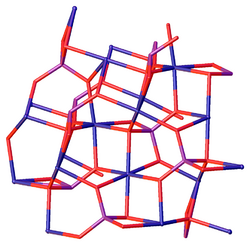Chemistry:Nickel(II) phosphate
From HandWiki

| |

| |
| Names | |
|---|---|
| IUPAC name
Nickel(2+) diphosphate
| |
| Other names
Nickel(III) phosphate, nickel diphosphate
| |
| Identifiers | |
3D model (JSmol)
|
|
| ChemSpider | |
| EC Number |
|
PubChem CID
|
|
| UNII | |
| |
| |
| Properties | |
| Ni3(PO4)2 | |
| Molar mass | 366.022924 g/mol |
| Density | 4.38 g/cm3 |
Solubility product (Ksp)
|
4.74×10−32[1] |
| Structure | |
| Monoclinic, mP26 | |
| P21/c, No. 14 | |
a = 0.58273 nm, b = 0.46964 nm, c = 1.01059 nm α = 90°, β = 91.138°, γ = 90°
| |
| Hazards | |
| Safety data sheet | www.fishersci.com |
| GHS pictograms |   
|
| GHS Signal word | Danger |
| H317, H334, H372, H410 | |
| P261, P272, P280, P284, P260, P264, P270, P273, P203Script error: No such module "Preview warning".Category:GHS errors, P302+352, P333+317Script error: No such module "Preview warning".Category:GHS errors, P321, P362+364Script error: No such module "Preview warning".Category:GHS errors, P304+340, P342+316Script error: No such module "Preview warning".Category:GHS errors, P319Script error: No such module "Preview warning".Category:GHS errors, P391, P318Script error: No such module "Preview warning".Category:GHS errors, P405, P501 | |
| NFPA 704 (fire diamond) | |
Except where otherwise noted, data are given for materials in their standard state (at 25 °C [77 °F], 100 kPa). | |
| Infobox references | |
Tracking categories (test):
Nickel(II) phosphate is an inorganic compound with the formula Ni3(PO4)2. It is a mint green paramagnetic solid that is insoluble in water.[2]
Hydrated nickel(II) phosphate
The hydrate Ni3(PO4)2·8(H2O) is a light green solid, which can be prepared by hydrothermal synthesis[3] and also occurs as the mineral arupite. It features octahedral Ni centers, which are bound to water and phosphate.[4]

References
- ↑ John Rumble (June 18, 2018) (in English). CRC Handbook of Chemistry and Physics (99 ed.). CRC Press. pp. 5–189. ISBN 978-1138561632.
- ↑ Calvo, Crispin; Faggiani, Romolo (1975). "Structure of Nickel Orthophosphate". Canadian Journal of Chemistry 53 (10): 1516–1520. doi:10.1139/v75-210.
- ↑ Perry, Dale L. (18 May 2011). Handbook of Inorganic Compounds, Second Edition. CRC Press. p. 292. ISBN 978-1-4398-1462-8. https://books.google.com/books?id=SFD30BvPBhoC&pg=PA292.
- ↑ Shouwen, Jin; Wang, Daqi; Gao, Xinjun; Wen, Xianhong; Zhou, Jianzhong (2008). "Poly[octaaquadi-μ-phosphato-trinickel(II)]". Acta Crystallographica Section E 64 (Pt 1): m259. doi:10.1107/S1600536807067050. PMID 21200596. Bibcode: 2008AcCrE..64M.259S.
- ↑ Ni, Bing; Liu, Huiling; Wang, Peng-Peng; He, Jie; Wang, Xun (2015). "General synthesis of inorganic single-walled nanotubes". Nature Communications 6: 8756. doi:10.1038/ncomms9756. PMID 26510862. Bibcode: 2015NatCo...6.8756N.
 |


